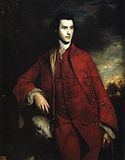Name Charles 3rd Spouse Mary Bruce (m. 1757) | Awards Knight of the Garter Siblings Lord George Lennox | |
 | ||
Prime Minister The Marquess of Rockingham Born 22 February 1735Westminster, London, England ( 1735-02-22 ) Parents Charles Lennox, 2nd Duke of Richmond, Sarah Lennox, Duchess of Richmond and Lennox Similar People Emily FitzGerald - Duchess, Charles Lennox - 2nd Duke, Lady Sarah Lennox, Lady Louisa Conolly, Charles James Fox | ||
Succeeded by The Earl of Shelburne | ||
Field Marshal Charles Lennox, 3rd Duke of Richmond, 3rd Duke of Lennox, 3rd Duke of Aubigny, (22 February 1735 – 29 December 1806), styled Earl of March until 1750, was a British Army officer and politician. He associated with the Rockingham Whigs and rose to hold the post of Southern Secretary for a brief period. He was noteworthy for his support for the colonists during the American Revolutionary War, his support for a policy of concession in Ireland and his advanced views on the issue of parliamentary reform. He went on to be a reforming Master-General of the Ordnance first in the Rockingham ministry and then in the ministry of William Pitt.
Biography
The son of Charles Lennox, 2nd Duke of Richmond and Sarah Lennox, daughter of William Cadogan, 1st Earl Cadogan, and brother of the famous Lennox sisters, he was educated at Westminster School and Leiden University and succeeded his father as Duke of Richmond in August 1750. He was commissioned as an ensign in the 2nd Foot Guards in March 1752, promoted to captain in the 20th Regiment of Foot on 18 June 1753 and was admitted a Fellow of the Royal Society on 11 December 1755.
Richmond became lieutenant-colonel of the 33rd Regiment of Foot on 7 June 1756. A second battalion (2nd/33rd) of this regiment was raised and in 1757, and the following year it became an independent regiment, the 72nd Foot; Richmond was appointed its lieutenant colonel, while his younger brother George took command of the 33rd Regiment (1st/33rd). In May 1758 he became colonel of the 72nd Regiment.
Richmond took part in the Raid on Cherbourg in August 1758 and served as aide-de-camp to Prince Frederick of Brunswick at the Battle of Minden in August 1759. Promoted to major-general on 9 March 1761, he saw the 72nd Regiment disbanded in 1763 at the end of the Seven Years' War. He was appointed Lord Lieutenant of Sussex on 18 October 1763.
Richmond was appointed British ambassador extraordinary in Paris and made a Privy Counsellor in 1765, and in the following year he briefly served as Southern Secretary in the Rockingham Whig administration, resigning office on the accession of Pitt the Elder in July 1766. He was promoted to lieutenant general on 30 April 1770 and was briefly leader of the parliamentary Whigs in opposition in 1771 when Rockingham's wife was ill.
Richmond's anti-colonial positions earned him the sobriquet "the radical duke." In the debates on the policy that led to the American Revolutionary War Richmond was a firm supporter of the colonists, and he initiated the debate in 1778 calling for the removal of British troops from America, during which Pitt (now the Earl of Chatham) was seized by his fatal illness. He also advocated a policy of concession in Ireland, with reference to which he originated the phrase "a union of hearts" which long afterwards became famous when his use of it had been forgotten. In 1779 Richmond brought forward a motion for retrenchment of the civil list, and in 1780 he embodied in a bill his proposals for parliamentary reform, which included manhood suffrage, annual parliaments and equal electoral areas.
Richmond joined the Second Rockingham Ministry as Master-General of the Ordnance in March 1782: he was appointed a Knight of the Garter on 17 April 1782 and promoted to full general on 20 November 1782. He resigned as Master-General when the Fox–North Coalition came to power in April 1783.
In January 1784 he joined the First Pitt the Younger Ministry as Master-General of the Ordnance; in this role he reformed the Department, introducing salaries for office holders, starting a survey of the South Coast (which led to the formation of the Ordnance Survey) and introducing new artillery (leading to the formation of the Royal Horse Artillery). He now developed strongly Tory opinions, and his alleged desertion of the cause of reform led to accusations of apostasy. In November 1795, when Thomas Hardy and John Horne Tooke were charged with treason and cited his publications on reform in their defence, Richmond became a liability to the Government and was dismissed in February 1795. He became colonel of the Royal Horse Guards on 18 July 1795 and was promoted to field marshal on 30 July 1796.
In retirement Richmond built the famous racecourse at the family seat of Goodwood. He was also a patron of artists such as George Stubbs, Pompeo Batoni, Anton Raphael Mengs, Joshua Reynolds and George Romney.
Richmond died at Goodwood on 29 December 1806 and was buried in Chichester Cathedral; he had married Lady Mary Bruce, daughter of the Earl of Ailesbury, on 1 April 1757 but left no legitimate children, so was succeeded in the peerage by his nephew Charles. He did have three illegitimate children by his housekeeper.
